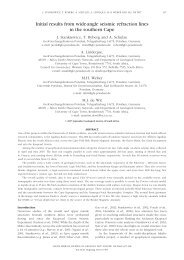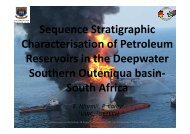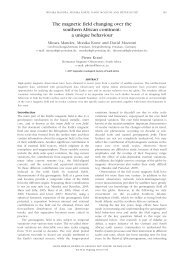South Africa - Inkaba.org
South Africa - Inkaba.org
South Africa - Inkaba.org
You also want an ePaper? Increase the reach of your titles
YUMPU automatically turns print PDFs into web optimized ePapers that Google loves.
Downscaling climate change scenarios to daily maximum<br />
temperatures over Bloemfontein, <strong>South</strong> <strong>Africa</strong><br />
P.C. Tharaga and A.S. Steyn<br />
Department of Soil Crop and Climate Science, University of the Free State, <strong>South</strong> <strong>Africa</strong>,<br />
2005162884@ufs4life.ac.za<br />
ABSTRACT<br />
Climate change refers to a change in the state of the climate that can be recognised by changes in the mean and/or<br />
the variability of its properties and that continues for an extended period, typically decades or longer. Climate<br />
change may be limited to a specific region, or may occur across continents or the whole planet. Global Circulation<br />
Models (GCMs) are the main source of climate projections under varying greenhouse gas emission scenarios, but<br />
their output needs to be downscaled before it can be interpreted for point stations. The main objective of this study<br />
was to downscale and quantify the projected changes in maximum temperatures that can be expected in<br />
Bloemfontein within the 21 st century.<br />
A statistical downscaling model (SDSM) was employed. SDSM reduces the task of statistical downscaling into the<br />
following discrete steps: quality control, predictor screening, model calibration, generation of ensembles of future<br />
data for the baseline climatic period using observed predictors, statistical analysis, generating of ensembles of<br />
future weather data using GCM-derived predictors, and time series analysis. The model was calibrated and tested<br />
with the use of observed datasets of daily temperature as the predictand and normalised NCEP variables as the<br />
predictors. SDSM was then used to construct downscaled daily temperature projections under the A2 and B2<br />
emission scenarios as obtained from the HadCM3 model. The projected changes for the future climate were<br />
assessed by means of delta statistics.<br />
Predictor screening revealed that the most important predictors for maximum temperature were mean sea level<br />
pressure and 500 hPa height, probably because of the relationship to column thickness (which were not available as<br />
a predictor variable). Wind direction was also included as a predictor variable because of its apparent influence on<br />
temperatures in mid-latitudes. Preliminary results of the downscaling model will be presented.<br />
KEYWORDS: climate change, statistical downscaling, maximum temperature<br />
79









